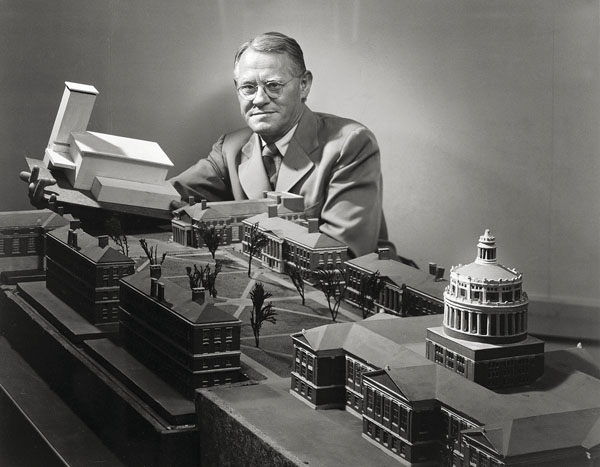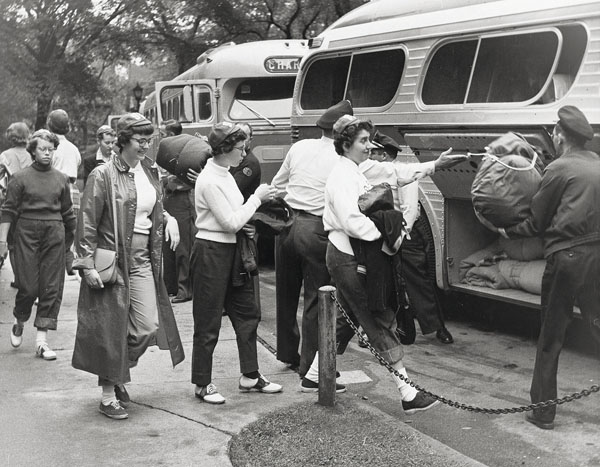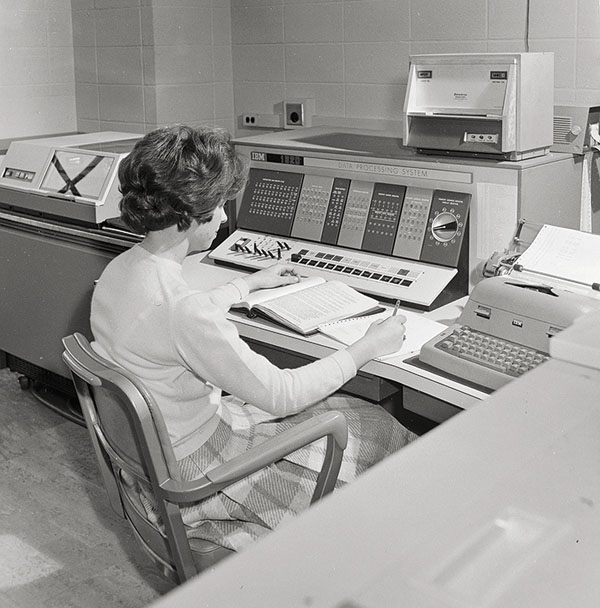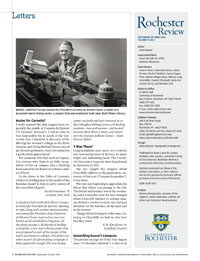Letters
 MODEL CAMPUS: Former University President Cornelis de Kiewiet holds a model of a proposed men’s dining center, a project that was eventually built near Rush Rhees Library. (Photo: University Libraries/Department of Rare Books, Special Collections, and Preservation)
MODEL CAMPUS: Former University President Cornelis de Kiewiet holds a model of a proposed men’s dining center, a project that was eventually built near Rush Rhees Library. (Photo: University Libraries/Department of Rare Books, Special Collections, and Preservation) (Photo: University Libraries/Department of Rare Books, Special Collections, and Preservation)
(Photo: University Libraries/Department of Rare Books, Special Collections, and Preservation)Who’s Getting on the Bus?
Class of 1958 members Dee Molinari, Nancy Kelts Rice, Joan Thornton Grimm, Paulette Rubin Rosenstein, and Dorothy Wynne were among the alumnae who wrote to identify the women getting on the bus in the opening photo of Class Notes for the July-August issue. The consensus is that the woman in the raincoat and holding her purse is Anne Gaffney Friday ’58. Behind her is Maryann Powers Pierleoni ’59, ’59N, and at the head of the line is Carol Spinuzzi Aceti ’58.
As for the identity of the fourth member of the party, there’s some debate. Some say it’s Marcia Bernstein Anderson ’58, and some say it’s Nancy Kelts Rice ’58.
Regardless, there’s agreement about why the women were getting on the bus. The photo was taken in 1954, says Molinari. “They were undoubtedly heading for Frosh Camp, I believe somewhere in the Bristol Hills.”—Scott Hauser.
Kudos for Cornelis?
I really enjoyed the July-August issue, especially the profile of Cornelis de Kiewiet (“A Dynamic Attitude”). I had no idea he was responsible for so much of the University that I attended in the early 1970s. Moving the women’s college to the River Campus and hiring Richard Fenno, one of my favorite professors, were two initiatives I particularly appreciated!
For someone who had such an impact, I’m curious why there is so little recognition of him on campus. Has a building been named in his honor or is there a statue of him? In the photo in the Table of Contents, what is he holding next to the model of the Eastman Quad? Is that an early version of the Interfaith Chapel?
David Grossman ’75
Armonk, New York
A residence hall south of the River Campus is named for President de Kiewiet. Opening in 1965, along with another dormitory that was named for President Alan Valentine, de Kiewiet Tower is part of an area now known as the Southside Living Area. In the photo on page 1, de Kiewiet is holding a model for a new men’s dining center that was proposed as part of the merger of the men’s and women’s colleges. The photo was taken as part of a fundraising campaign to help support the merger. The new dining center was built and later renamed as today’s Douglass Dining Center, still feeding students—men and women—and located between Rush Rhees Library and what’s now the Goergen Athletic Center. —Scott Hauser, Editor.
‘I Was There’
Congratulations once more on a colorful and interesting issue of Review. So many bright and interesting faces. The University has come a long way since I graduated in chemistry in 1941.
My eye caught the snippet about Churchill’s address to the graduation ceremony of that year (“Campus Keepsakes”). I was there.
We were just beginning to appreciate the threat that Hitler was posing to the UK. The British ambassador was at the ceremony, and I remember how his face changed when Churchill intoned in solemn stanzas Britain’s resolve to resist any German invasion “on the beaches, on the land, and in the streets.”
Things did not look good at the time. Listening to Churchill, we had no idea how bad they were.
F. H. Kim Krenz ’41
Lakefield, Ontario
 IT’S A 1620: Readers noted that a photo of early computers at Rochester showed an IBM 1620, a model announced in 1959. (Photo: University Libraries/Department of Rare Books, Special Collections, and Preservation)
IT’S A 1620: Readers noted that a photo of early computers at Rochester showed an IBM 1620, a model announced in 1959. (Photo: University Libraries/Department of Rare Books, Special Collections, and Preservation)Something Doesn’t Compute
The picture on page 44 of the July-August issue (“A Dynamic Attitude”) is that of an IBM 1620, which wasn’t announced until late in 1959, so it couldn’t have been the “desk-sized machine” alleged as installed in 1955 in the University’s “first computer center.”
The notion of a “computing center” was new in universities in the 1950s; UR had one of the first such centers established, with Tom Keenan as its director. The Institute of Optics was hugely instrumental in establishing the center at the urging of Bob Hopkins, an early believer and strong proponent of computing as a centralized utility.
The year 1955 was, thankfully, before my time, as was the Burroughs E101, which I believe was the first “real” computer installed at UR, replacing Marchant and Friden desktop (mechanical) calculators as a central computing resource for the University. The E101 was desk-sized.
I arrived as a freshman in 1959, and by that time (“sometime in the 1950s,” according to the IBM archives) the E101 had been replaced by an IBM 650. The 650 was not by any means a “desk-sized” computer, but with a large control panel of blinking lights and a room full of support equipment, it was sufficiently intriguing to undo any aspirations I had of becoming a physicist. I must have looked like J. Thaddeus Toad when he saw his first motorcar.
Centralized computing was not universally embraced at UR. The engineering school maintained a 1620 (later an IBM 1130), the business school went with Univac, and the Laser Lab got the mother of all scientific machines at the time, a Control Data Corporation (CDC) 6600—diversity at its finest. The central 650 was replaced in 1961 by an IBM 7070, and later by the 7070’s successor (the 7074) and, in the late 1960s, the IBM System/360. The Computing Center has used mainstream IBM computers ever since, as far as I know.
But those were, to me, the good old days of wooden computers and iron programmers. When I left the Computing Center in 1980, I felt I knew the room-sized computer systems thoroughly, from the hardware to the operating systems and most of the application programs. Now I carry a small computer in my pocket that has more memory and more computing power than all of NASA’s computers when they put Neal Armstrong on the moon, and I have no idea how it works. And it also makes phone calls.
Michael Armstrong ’63
Polk City, Florida
Engineering operated an IBM 1620 in Hopeman like the one shown on page 44. However, these were not announced by IBM until October 1959. The University at that time ran an IBM 650 that occupied much of Taylor Hall. I’m not sure what if anything may have preceded it, but it would surely not have been desk-sized.
Roger Ehrich ’65
Blacksburg, Virginia
Connected to South Africa
I was interested to read the article “Global Rochester: South Africa” (July-August) because I was born and grew up in South Africa. Sent by the South African Atomic Energy Board, I went to Rochester initially to participate in the joint program between the U of R and the Brookhaven National Laboratory to train health physicists for the U.S. Atomic Energy Commission. Upon completion of that program, I returned to Rochester to study for a PhD in the Department of Radiation Biology and Biophysics at the School of Medicine and Dentistry under the late Dr. Paul E. Murrow. I went back to head the Health Physics Subdivision at the South African Nuclear Research Center in 1964, but I returned to the USA as an immigrant in March 1969. I assumed a position in the inhalation toxicology section of the biology department at Battelle Northwest in Richland, Washington, under Dr. William J. Bair ’54M (PhD). I spent about 14 years as an inhalation toxicologist in Richland and at the Battelle Memorial Institute in Columbus, Ohio. I retired from full-time work after more than 12 years as a toxicologist at the Savannah River Site in Aiken, South Carolina. Douglas Craig ’61M (MS), ’64M (PhD) Ponce Inlet, Florida It is little known that the University of the Witwatersrand in Johannesburg, South Africa, has strong historic links with the University. Cornelis de Kiewiet, the University’s president from 1951 to 1961 was a graduate of Witwatersrand for his bachelor’s and master’s degrees, while Cyril Myerowitz, a dental graduate of Witwatersrand was director of the Eastman Dental Center from 1999 to 2009. The connections continue with 18 Rochester alumni living in South Africa, and currently four undergraduates and one graduate student from South Africa studying at Rochester.
As a dual graduate of both universities, I elicit interest of possible other dual graduates of “Wits” and Rochester.
G. H. Sperber ’62D (MS)
Edmonton, Alberta
The writer is a professor emeritus at the University of Alberta. Write to him at gsperber@ualberta.ca.
Department of Corrections
Thank you for listing my book in the July-August edition of Review. I have already reconnected with the family of John Montean, my advisor during my graduate work in the then Department of Education. It was a wonderful outcome of the listing.
However, I must correct the information that you listed. My book, Bonnets to Boardrooms: Women’s Stories from a Historic College Town, is not based solely on interviews of women graduates of Oberlin College, but of the women who lived in the town of Oberlin, Ohio. The town of Oberlin, a community known for its progressive attitudes, provides the backdrop to these stories, but they could have originated in any small town.
Vignettes showcase those with national influence, such as Jeanne Pease, wife of a U.S. congressman, local figures, such as Oberlin’s first African-American public school teacher, Elizabeth Thomas, and others merely sharing everyday occurrences that give vibrancy to life, such as Mildred Chapin learning to drive an automobile in the early 1900s.
Eugenia Vanek ’74W (EdD)
Saint Petersburg, Florida
Review welcomes letters and will print them as space permits. Letters may be edited for brevity and clarity. Unsigned letters cannot be used. Send letters to Rochester Review, 22 Wallis Hall, P.O. Box 270044, University of Rochester, Rochester, NY 14627-0044; rochrev@rochester.edu.

